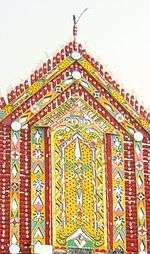Biffeche

Biffeche or Bifeche is an area of Senegal centred on the town of Savoigne, around 30 kilometres north-east of the major coastal city of Saint-Louis.
| Part of a series on |
| Serers and Serer religion |
|---|
  |
|
Deities |
|
Main doctrines |
|
Sacred places
|
|
Notable figures
|
|
Relations with other religions |
|
Education |
|
See also
|
|
Low-lying and largely flat, the region has Fula,[1] Serer-Ndut people (the original founders of Biffeche and Mt Rolland, and strong adherents to Serer religion,[2][3][4][5] even after the French and the Muslim communities of Senegal tried to kill them off[6][7]), Wolof and Moor ethnic groups engaged in pasturing animals (mainly the Fulas) and irrigation-based agriculture (mostly the Serer-Ndut who are usually mixed-farmers[7]). Savoigne is the region's largest town, twinned with La Ferté Macé; its SOCAS tomato-paste factory imports and dilutes tomato paste for re-shipment within Senegal. The population is primarily Muslim, but also contains Catholics and animists. The Djoudj National Bird Sanctuary is located to the north.
Early European accounts used the word for a different location, describing a medium-sized island (Isle de Bifeche) in the delta of the Senegal River in West Africa, some two miles upstream from the island of N'Dar on which Saint-Louis was founded. The Penny Cyclopædia of the Society for the Diffusion of Useful Knowledge described the island in 1843 as being "entirely covered with wood, and in the wet season a great portion of them is laid under water."
Currently, the river marks this section of the border between Mauritania and Senegal. The island can perhaps most easily be seen on the map with one of its main towns Maka clearly marked. A contemporary map can be found at - this map shows N'Dar under its older French name of Isle St. Louis and the Pointe de isle de Bifeche is also visible. On the island is written Emboulan which appears to be a European variant of a local town name Mboubène. It can also be just seen at the extreme top of Senegal in 1753.
In the 17th century a chief known as the Petit Brak or Little King ruled over a region known variously as Biffeche or Gangueul with capital at Maka. The Grand Brak or Big King ruled the kingdom of Waalo, whose capital was originally at Diourbel. The area was nearly depopulated by repeated slaving raids by Moors from the north. At times, the Petit Brak was tributary to Waalo, at other times allied with Bethio. In the 1720s, the Brak of Waalo was Erim M'Bagnick and Béquio Malicouri, king of the Royaume d'Oral (Bethio), was his vassal.
References
General
- Barry, Boubacar. Le royaume du Waalo - Le Senegal avant la conquete. Karthala, 1985.
- Becker, Charles and Martin, Victor. Journal Historique et Suitte du Journal Historique (1729-1731) 39.2 (1977): 223-289.
- Cultru, Prosper. Premier voyage du Sieur de la Courbe.... Paris: Larose, 1913.
- Encyclopedie, dictionnaire raisonné des sciences, des arts et des métiers, par une société de gens de lettres, mis en ordre et publié par Mr. * * *, tome quinzieme. Neufchastel, France: Samuel Faulche, 1765. Facsimile page
- Knight, Charles. The Penny Cyclopædia of the Society for the Diffusion of Useful Knowledge, Vol. XXI. London, 1843: 231. Public domain copy
- Labat, Jean-Baptiste. Nouvelle Relation de l’Afrique occidentale. Paris: Cavelier, 1727. t. 2, p. 174.
- Thésée, Françoise. Actes du colloque de Nantes, tome I. 1988. 223-245. .
- Thilmans, Guy. Bull. Les planches sénégalaises et mauritaniennes des “Atlas Vingboons” , G. IFAN, B. t. 37.1 (1975): 106-109.
- Gravrand, Henry, "La civilisation Sereer - Cosaan : les origines, vol.1, pp 140-146, Nouvelles Editions Africaines, 1983, ISBN 2-7236-0877-8
- Echenberg, Myron J, "Black death, white medicine: bubonic plague and the politics of public health in colonial Senegal, 1914-1945", pp 141–146, Heinemann (2002), ISBN 0-325-07017-2
- Klein, Martin A., "Islam and Imperialism in Senegal, Sine-Saloum", pp VII-5, Edinburgh University Press, (1968), ISBN 0-85224-029-5
- Dupire, Marguerite, "Sagesse sereer: Essais sur la pensée sereer ndut",
- Becker, Charles, "Les Serer Ndut: Études sur les mutations sociales et religieuses", Microéditions Hachette (1974)
Notes
- ↑ In French: Peul or Peulh; in Fula: Fulɓe.
- ↑ Gravrand, Henry, "La civilisation Sereer - Cosaan : les origines, vol.1, pp 140-146, Nouvelles Editions Africaines, 1983, ISBN 2-7236-0877-8
- ↑ For more about the Serer-Ndut people, see : Dupire, Marguerite, "Sagesse sereer: Essais sur la pensée sereer ndut",
- ↑ Klein, Martin A., "Islam and Imperialism in Senegal, Sine-Saloum" 1847-1914, pp vii-5, Edinburgh University Press, (1968), ISBN 0-85224-029-5
- ↑ Serer-Ndut people in Lingua Món Casa de les Llengües
- ↑ Becker, Charles, "Les Serer Ndut: Études sur les mutations sociales et religieuses", Microéditions Hachette (1974)
- 1 2 Echenberg, Myron J, "Black death, white medicine: bubonic plague and the politics of public health in colonial Senegal, 1914-1945", pp 141-146, Heinemann (2002), ISBN 0-325-07017-2,
Historical maps
- Cours de la rivière de Sanaga ou Sénégal depuis son embouchure jusqu'à l'île de Bilbas / Suite du cours de la rivière de Sénégal depuis l'isle de Bilbas jusqu'au sault du Rocherde Govina / levé par un ingénieur francois, 1718. Online at BNF
- Carte de la rivière du Sénégal depuis la Barre jusqu'au Panier Foule des petites rivières et marigots qui en dérivent avec les noms des villages qui sont au bord, fait au Sénégal, 1720. Online at BNF
- Anville, Jean-Baptiste Bourguignon, Carte manuscrite de la côte d'Afrique aux environs de Gorée et de la rivière du Sénégal depuis Cagneux jusqu'à son embouchure. 1724. Online at BNF
External links
- Google Maps satellite image of the Senegal River delta
- Area Map
- History (in French)
- Ethnicity (in French)
- Religion (in French)
- Senegalese History and Geography (mainly in French)
- Horticulture (in French)
- Parc du Djoudj
- Indigenous chief Béquio Malicouri